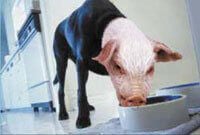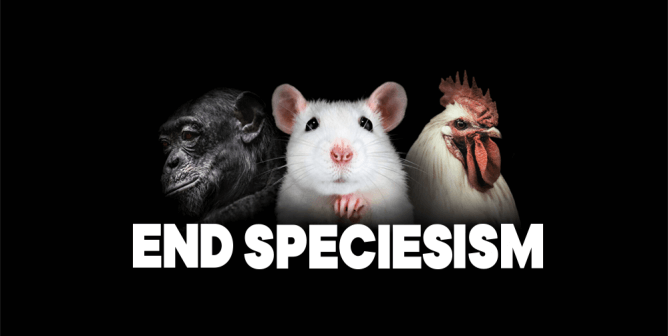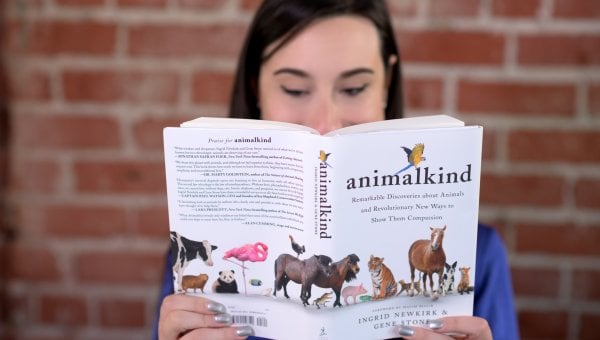If Your Dog Tasted Like Pork, Would You Eat Her?
We wouldn’t serve our dogs for dinner—but what do our pooches have that pigs don’t? Anyone who has spent time around pigs can attest that they are just as loving, intelligent, and capable of feeling pain and suffering as our canine companions. So why do we call one “friend” and the other “food”?
Bringing home the bacon and other meats means certain death for lovable, smart, social pigs and other animals. Given the opportunity and training, pigs can play certain computer games about as well as college students, turn on lights and heat in a barn, and perform many other sophisticated activities. Intelligent, inquisitive, and pleasant-natured animals, pigs can be loyal, playful, affectionate companions and have been known to save people from drowning—yet people don’t return the favor, and many who couldn’t stomach the thought of eating their dogs routinely consume pig flesh.
Some might ask, “Pigs are bred for food, so what’s wrong with eating them?” But of course, in many Asian countries, we could pose the same question about dogs. Basic biology tells us that being bred for a certain purpose does not change an animal’s capacity to feel pain, fear, or sorrow. Animals who are bred for human consumption still suffer greatly at the hands of factory farmers and slaughterhouse workers.
In a Pig’s Eye
As Karl Schwenke points out in his classic 1985 book, In a Pig’s Eye,
On factory farms, sows are no longer allowed to be the good mothers that nature intended. Instead, they are treated as inanimate “meat machines,” squeezed into narrow metal stalls barely larger than their own bodies, and kept constantly pregnant or nursing. Immobilized, mother pigs are unable even to nuzzle their piglets. Pigs’ tails are chopped off and their teeth are cut with pliers—and males are castrated—all without painkillers. At the end of their miserable lives, they get their first breath of fresh air as they are trucked to the slaughterhouse. Finally, they are hung upside-down and bled to death, often, according to slaughterhouse workers and U.S. Department of Agriculture meat inspectors, while still conscious and screaming.
People who take the time to really learn about pigs realize that they aren’t emotionless machines whose lives are inconvenient stages on the way to our dinner tables. They are living, breathing, and feeling beings who want to lead their lives free from suffering, just like our faithful dogs and cats do.
The biggest difference between pigs and dogs is the way we treat them! Despite the fact that pigs are highly intelligent, sentient beings who feel pain every bit as much as we do, they are regarded in terms of “inputs,” “outputs,” and profits by the factory-farming industry. Like many other factory-farmed animals, pigs are not even perceived as living beings. Rather, these animals, who are horrified at the sight and smells of the slaughterhouse and who will fight to save their lives, are treated as mere production units on an assembly line.
People from some cultures eat dogs, and some people eat pigs, but with a world of vegetarian foods to choose from, it’s high time we left all animals off the menu. The best way to show all animals some real respect is to stop eating them. Click here to learn how you can leave pork off your plate and adopt a healthy and humane vegetarian diet.
Dig These Pig Facts
- Pigs dream and see in color.
- Pigs outperform 3-year-old human children on cognition tests and are smarter than any domestic animal, and animal experts consider them more trainable than cats or dogs.
- Pigs are naturally slender. They only become fat when humans overfeed them.
- Pigs are sociable. They like to cuddle and snuggle up, nose to nose, with one another as they sleep.
- In the wild, pigs live in matriarchal societies, as elephants do.
- Piglets love to chase each other, play-fight, and roll down hills.
- Pigs can be picky eaters: When given the same food, even a favorite one, such as melon or banana, over and over, they will soon set them aside and eat their other food first. When pigs are offered a new food, they don’t gobble it right up, as a dog might, but sniff at it delicately as they decide whether or not to try a nibble.
- Pigs are hygienic. When given the chance, they are more particular about their sanitary behavior than most dogs. They will not, unless locked inside a factory-farm cage, defecate anywhere near their living space.
- Pigs roll in mud to cool down and ward off parasites and sunburn, just as elephants do.
Feeling inspired? Check out Animalkind, a bestselling book full of fascinating facts and amazing stories about animals!






